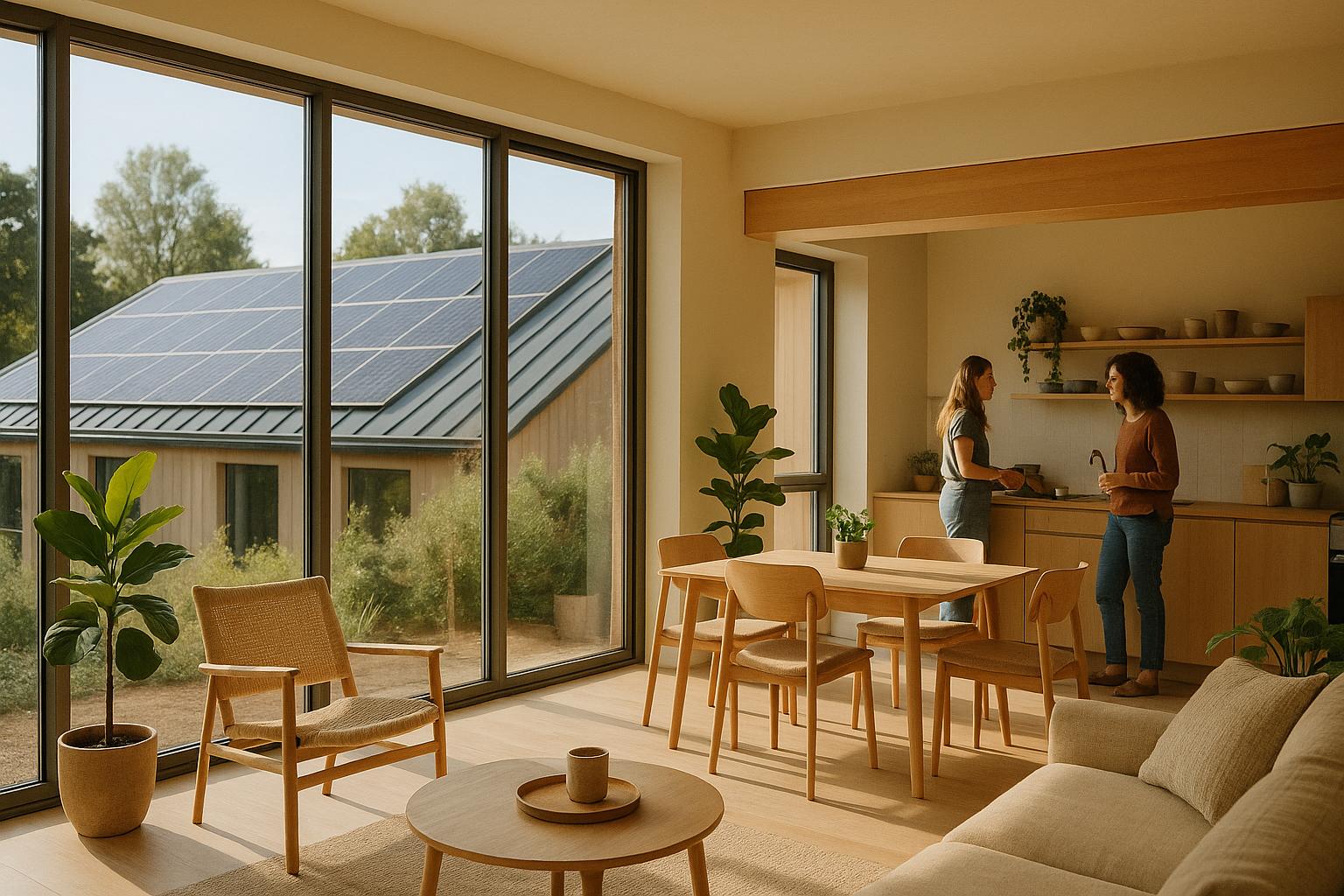Securing long-term tenants for your coliving space is all about creating a place people want to stay. Long-term residents provide steady income, reduce turnover costs, and build a sense of community that short-term stays can't match. Here's how you can attract and retain them:
- Know Your Audience: Understand tenant needs - remote workers want fast internet and quiet spaces, while young professionals prioritize networking opportunities.
- Tailor Amenities: Offer features like study areas for students, coworking spaces for remote workers, or social spaces for professionals.
- Build Community: Host events like dinners, networking sessions, and game nights. Clear rules and tenant involvement keep things running smoothly.
- Flexible Leases: Offer options like month-to-month or annual leases, and reward longer commitments with discounts or perks.
- Design Smart Spaces: Balance shared areas for socializing with private rooms for personal time. Include all-inclusive pricing for simplicity.
- Stay Connected: Use feedback systems and tenant screening to ensure satisfaction and maintain harmony.
Know Your Target Tenant Groups
Understanding your ideal tenant groups is crucial for creating spaces that meet their needs and resonate with their lifestyles. When you clearly define your target audience, you can shape everything - amenities, marketing messages, and overall design - to address their specific priorities. The goal is to focus on particular tenant profiles rather than trying to cater to everyone. For instance, a property tailored for remote workers will differ significantly from one designed for graduate students or young professionals. By pinpointing these profiles, you can better align your offerings with tenant expectations.
Define Your Ideal Tenant Profiles
To define your tenant profiles, consider factors like lifestyle, work habits, and values. Here’s how different groups might look:
- Remote workers and digital nomads need fast, reliable internet, quiet workspaces, and flexibility with lease terms. They often prioritize convenience and adaptable living arrangements.
- Young professionals in their twenties and thirties are career-focused and value networking opportunities. They seek properties in prime locations with community-oriented spaces and practical features that fit their fast-paced lives.
- Graduate students and researchers require quiet, budget-friendly housing options with long-term stability. Study spaces, intellectual environments, and a sense of community are important to them.
- Transitional tenants, such as those relocating for new jobs or life changes, often prefer furnished accommodations and benefit from the social connections coliving spaces provide during their transitions.
To better understand your target audience, gather feedback through surveys, interviews, and online forums. Ask about their housing challenges, preferred amenities, and what would make them stay longer. These insights help you refine your tenant profiles and focus your efforts where they matter most.
Match Your Amenities to Tenant Needs
Once you’ve identified your tenant profiles, align your amenities to address their specific challenges and priorities.
- For remote workers, provide high-speed Wi-Fi with backups, soundproof workspaces, and plenty of power outlets. Features like private call booths or Zoom rooms can make your property stand out.
- For young professionals, choose locations with easy access to public transit, popular dining spots, and entertainment. Community spaces that encourage networking are also a big plus.
- For students and researchers, think about quiet study areas, well-lit reading corners, and secure storage. Amenities like dedicated study rooms, whiteboards, and reliable printing facilities can enhance their experience.
Build a Strong Community Environment
Creating a strong sense of community transforms a coliving space into a true home. By encouraging organic connections and setting clear guidelines for shared living, you can keep tenants engaged and satisfied for the long haul. These efforts not only strengthen bonds but also establish a foundation of consistent and transparent community standards.
Plan Regular Social and Networking Events
Hosting regular events is a great way to help tenants connect naturally and build lasting relationships. The key is to organize activities that align with their interests and fit into their schedules.
- Monthly themed dinners: Bring everyone together with potlucks or cooking classes centered around fun themes. These shared meals create opportunities for meaningful interactions.
- Professional networking sessions: Events like "Coffee & Careers" cater to young professionals and remote workers. These meetups allow residents to share work experiences, discuss industry trends, and even collaborate on projects, blending personal connections with professional growth.
- Skill-sharing workshops: Tap into the diverse talents of your tenants. For example, one resident could teach photography basics, while another hosts a session on budgeting or language exchange. These workshops highlight the unique benefits of living in a diverse community.
- Game nights and movie screenings: Organize board game tournaments, trivia nights, or movie marathons in common spaces. These casual activities help residents relax and form friendships.
Monthly gatherings strike the right balance - frequent enough to build connection without overwhelming tenants. To ensure participation, survey residents about their preferences and adjust event timing accordingly.
Of course, successful events are easier to manage when supported by clear community guidelines.
Set Clear Rules for Shared Living
Clear, well-communicated rules are essential for maintaining harmony in a shared living environment. They help prevent conflicts and create a predictable, fair atmosphere that encourages long-term satisfaction.
- Common area policies: Establish rules for peak usage times, booking systems, and cleanup responsibilities. Quiet hours are crucial - consider 10:00 PM to 8:00 AM on weekdays and 11:00 PM to 9:00 AM on weekends. For shared spaces like meeting rooms, implement a simple reservation system to avoid scheduling conflicts.
- Kitchen and dining rules: Food-related disputes can escalate quickly, so set clear expectations. A "clean as you go" policy works well, with a two-hour limit for leaving dishes in common areas. Provide individual storage spaces and guidelines for sharing fridge and pantry space.
- Guest policies: Strike a balance between social flexibility and community comfort. Require tenants to notify housemates 24-48 hours in advance of overnight guests, and limit consecutive stays to prevent unofficial subletting. Guests should also follow the same rules as residents.
- Noise and privacy boundaries: Define acceptable noise levels for different times of day and ensure these are consistently enforced. For common areas, establish guidelines that respect those who may be working or studying nearby.
Document these rules in a tenant handbook, make it available online, and review it periodically to ensure it remains relevant and effective.
Get Tenants Involved in Community Decisions
Encouraging tenant involvement in decision-making fosters emotional investment and reduces turnover. When residents feel their voices are heard, they’re more likely to stay engaged.
- Monthly community meetings: These structured gatherings allow tenants to share input on house rules and amenity improvements. Keep meetings focused with prepared agendas and limit them to 60-90 minutes. Rotate schedules to accommodate everyone.
- Tenant committees and feedback systems: Create committees and use tools like surveys or suggestion boxes to gather input. These groups can operate semi-independently but report back to the community, offering multiple ways for residents to contribute.
- Budget transparency: Share details about community improvement funds and let tenants vote on priorities. This approach sets clear expectations and shows how their feedback impacts their living environment.
- Conflict resolution processes: Involve tenant representatives in resolving disputes to ensure fair outcomes. Train mediators for minor issues and establish clear steps for escalating serious concerns. When tenants help address conflicts, they feel more invested in maintaining harmony.
To reinforce the value of tenant input, share monthly updates about changes made based on their suggestions. Highlight improvements, upcoming decisions, and ways to stay involved. A well-organized, participatory community not only boosts tenant loyalty but also reduces turnover costs.
Structure Lease Terms That Attract Long-Term Stays
Creating lease terms that cater to different tenant needs can not only increase occupancy but also reduce the costs tied to frequent turnover. By offering varied lease options and meaningful incentives, you can encourage tenants to commit to longer stays.
Offer Multiple Lease Length Options
Providing a variety of lease lengths can attract a diverse tenant base and adapt to their changing circumstances. For example, month-to-month leases are ideal for professionals in transition, remote workers, or those who value flexibility. On the other hand, six-month and annual leases strike a balance between adaptability and stability, making them suitable for seasonal workers or professionals looking for more predictability. These longer terms also reduce marketing efforts and ensure consistent income.
When possible, consider offering customized lease terms to accommodate unique situations. Be transparent about pricing to reflect the value of each lease option - shorter terms may require slightly higher rates to offset the increased turnover costs. To retain tenants, begin renewal discussions well before the lease ends, giving everyone time to plan ahead. These flexible lease structures align well with a community-focused environment by addressing the diverse needs of your tenants.
Reward Tenants for Longer Commitments
Incentives can make longer lease terms more appealing while demonstrating your dedication to tenant satisfaction. Offering rent discounts for extended commitments provides a clear financial benefit compared to shorter leases. Move-in perks, such as waived security deposits, reduced introductory rates, or complimentary room upgrades, can also attract prospective tenants right away.
To keep tenants engaged long-term, consider ongoing benefits like service credits for housekeeping, priority booking for shared spaces, or discounts through local partnerships. Loyalty programs are another effective strategy, rewarding lease renewals with perks like rent freezes, room upgrades, or access to new amenities. Referral bonuses tied to the length of a tenant’s lease can further encourage them to stay and recommend your property.
You can also support long-term tenants by offering flexible upgrade policies. Allowing tenants to change rooms without penalties or giving them priority access to premium spaces can meet their evolving needs while keeping them committed. Early renewal incentives - such as extra perks for signing a new lease before the current one ends - can also help secure their continued tenancy.
Tailoring these strategies to your target audience is key. For example, young professionals might value access to coworking spaces or networking events, while students may prefer leases aligned with the academic calendar and priority access to study areas. Regularly gathering tenant feedback can help fine-tune these offerings, ensuring they remain effective and appealing.
Design Spaces That Keep Tenants Happy
The way a space is designed has a direct impact on how tenants feel about their living environment - and whether they choose to stay long-term. Spaces that focus on comfort, practicality, and openness create a welcoming atmosphere that encourages tenants to renew their leases and recommend the space to others. When paired with smart lease terms and community-focused initiatives, thoughtful design becomes a cornerstone of tenant loyalty. These principles work hand in hand with your efforts to build a strong sense of community, creating spaces where people naturally want to stay.
Use All-Inclusive Pricing Models
Simplifying costs with an all-inclusive pricing model can make life easier for tenants while also streamlining operations for you. By bundling utilities, high-speed internet, cleaning services, and maintenance into one fixed monthly rent, tenants can avoid the hassle of juggling multiple bills. This approach is especially appealing to young professionals and remote workers who value predictability in their expenses. It also saves you from dealing with constant coordination over utility payments or service disruptions.
Consider going a step further by including additional perks in your all-inclusive package. For example, some operators offer weekly cleaning for shared spaces, high-speed internet suitable for video calls, streaming services, or even essentials like toiletries and cleaning supplies. While these extras might increase your upfront costs, they often justify slightly higher rents and leave tenants feeling they’re getting good value.
Transparency is key here. Provide a clear breakdown of what’s included in the rent and what isn’t. This helps tenants see the value of the arrangement compared to traditional rentals, where separate bills and hidden fees are the norm.
Maintain High Standards for Upkeep
The condition of a property speaks volumes. Clean, well-maintained spaces not only make a great first impression but also play a huge role in tenant retention. On the flip side, neglected properties with ongoing maintenance issues can quickly lead to frustration and early move-outs.
Set up a regular maintenance schedule to handle both preventive care and repairs. Aim to address non-urgent issues within 48 hours and emergencies within 4 hours to show tenants you’re serious about their comfort.
Invest in durable materials and furnishings that can handle wear and tear. While the upfront cost might be higher, quality items like leather or microfiber furniture, quartz countertops, and commercial-grade flooring are easier to maintain and last much longer.
Make it simple for tenants to report maintenance requests by offering multiple channels, such as an app, email, or online portal. Regular property inspections - monthly for shared spaces and quarterly for private rooms - can help you spot and address potential issues before they escalate.
Balance Common Areas with Private Spaces
The best coliving spaces strike a balance between fostering community and respecting individual needs. By creating distinct zones for socializing and solitude, you can meet the varied preferences of tenants throughout their day.
Common areas should encourage natural interaction. Open-concept kitchens with large islands or breakfast bars are great for casual conversations while cooking or eating. Living rooms can feature a mix of seating options - like large sectionals for group activities and individual chairs for quieter moments.
Incorporate quiet zones into shared spaces for those who want a break from the hustle and bustle. A cozy reading nook with good lighting, a workspace with individual desks, or a meditation corner with comfortable seating and greenery are all great options. These areas provide a sense of calm without isolating tenants completely.
Private rooms, on the other hand, should feel like personal sanctuaries. Equip them with practical features like ample storage, blackout curtains, soundproofing, and bedside tables with charging ports. Small touches like mirrors or personal lighting options can make these spaces feel even more inviting.
Don’t forget outdoor spaces - they can offer a mix of communal seating for socializing and quiet spots for reflection. Whether tenants want to share a meal with housemates or enjoy some alone time, having flexible options ensures they feel at ease in their environment.
The ultimate goal is to give tenants the freedom to choose how they engage with the community. Some days they might love cooking and chatting with housemates, while other days they might prefer a quiet evening in their room. Thoughtful design ensures both choices feel equally natural and comfortable.
Use Tools to Keep Tenants Engaged and Satisfied
Building strong relationships with your tenants and understanding their needs are key to keeping them around for the long haul. Using the right tools for feedback and tenant screening can make a big difference in tenant retention.
Create Systems for Regular Tenant Feedback
Digital surveys are a great way to measure tenant satisfaction. Keep these surveys short and focused on areas like cleanliness, community vibe, and how quickly maintenance requests are handled. To encourage participation, consider offering small incentives, like gift cards or discounts.
But surveys aren’t the only way to gather feedback. Scheduling regular one-on-one check-ins can uncover concerns or suggestions that might not surface in a survey. Adding an anonymous suggestion box is another way to give tenants a safe space to share their thoughts.
Keeping the conversation going is essential. Digital platforms, such as group messaging apps or community forums, can help tenants feel heard and connected. Be clear about how and when you’ll respond to feedback - it shows you value their input and builds trust.
This ongoing communication naturally sets the stage for thoughtful tenant selection.
Screen Tenants for Community Fit
Careful tenant screening helps reduce turnover and creates a harmonious living environment. Beyond checking credit scores and employment history, focus on finding tenants who are genuinely interested in shared living arrangements. A structured interview that explores their ideal living setup and past experiences with shared housing can provide helpful insights.
You can also create a compatibility checklist that looks at factors like lifestyle, work hours, and cleanliness habits. Reference checks are another valuable step - asking about a candidate’s willingness to pitch in with shared responsibilities can reveal a lot. Hosting meet-and-greet sessions is another way to assess how well a potential tenant might fit into the community.
For added flexibility, consider offering an initial trial period or a shorter lease. This gives both parties a chance to evaluate if the arrangement is a good match. Use feedback from these experiences to continuously improve your screening process.
Conclusion: Your Path to Long-Term Tenant Success
Securing long-term tenants involves a combination of well-thought-out strategies that cater to their needs and enhance their living experience. By understanding your target tenant groups and aligning your amenities with their preferences, you lay the groundwork for lasting relationships.
Creating a welcoming community plays a key role in tenant retention. Hosting regular social events, establishing clear house rules, and involving tenants in decisions fosters a sense of belonging that encourages them to stay.
Your lease terms and pricing structure are equally critical. Providing flexible lease options while rewarding extended commitments strikes a balance between tenant convenience and value. All-inclusive pricing simplifies expenses, removing one of the common frustrations of shared living arrangements.
The design of your space also matters. Well-maintained communal areas that inspire social interaction, paired with private spaces where tenants can unwind, create an environment that feels both engaging and comfortable. This balance between community and privacy strengthens tenant satisfaction.
Additionally, the tools you use to connect with and screen tenants are essential. Regular feedback loops allow you to address concerns early, while careful screening ensures you attract individuals who genuinely appreciate the coliving experience.
FAQs
How can I better understand the needs of potential tenants for my coliving space?
To get a clear picture of what potential tenants are looking for, start by analyzing their lifestyle, preferences, and priorities. Think about key factors like their age, career stage, social interests, and budget. For instance, young professionals might be drawn to spaces that encourage networking, while remote workers could lean toward properties with quiet, well-equipped work areas.
It's also smart to dive into local market trends and understand what motivates tenants in your area. Are people searching for affordable housing, community-focused living spaces, or flexible lease terms? You can gather useful insights by conducting surveys, hosting community events, or even engaging in one-on-one interviews. By tailoring your offerings to meet these expectations, you'll create a space that not only attracts tenants but also keeps them around for the long haul.
How can I create a strong sense of community to attract and retain long-term tenants in my coliving home?
Building a strong sense of community in your coliving space is crucial for attracting and keeping long-term tenants. One way to achieve this is by hosting regular social activities like shared meals, game nights, or workshops. These events provide opportunities for residents to connect, build relationships, and feel more engaged with their living space.
Creating inviting communal areas is another important step. Think cozy lounges, shared kitchens, or outdoor spaces where people naturally come together. When these areas are both comfortable and functional, they encourage interaction and help residents feel at home.
Lastly, prioritize tenant compatibility by using a thoughtful screening process. Pairing residents with similar values, interests, or lifestyles can lead to stronger connections and a more harmonious living environment. By focusing on these elements, you’ll cultivate a lively and connected community that tenants will want to call home for the long haul.
How do flexible lease terms and all-inclusive pricing help attract and keep long-term tenants in a coliving home?
Flexible lease terms and straightforward pricing make coliving homes a popular choice by combining convenience, ease, and financial transparency. Lease options range from short stays to year-long arrangements, catering to a variety of lifestyles - whether you're relocating, working remotely, or simply exploring a new city. This kind of flexibility allows tenants to commit without the stress of rigid, long-term contracts.
With all-inclusive pricing, living expenses are bundled into one monthly payment that covers rent, utilities, and amenities. This not only simplifies budgeting but also eliminates unexpected charges, offering a stress-free living experience. Together, these features provide a practical and appealing solution for those looking for a balance of stability and convenience in their housing.






